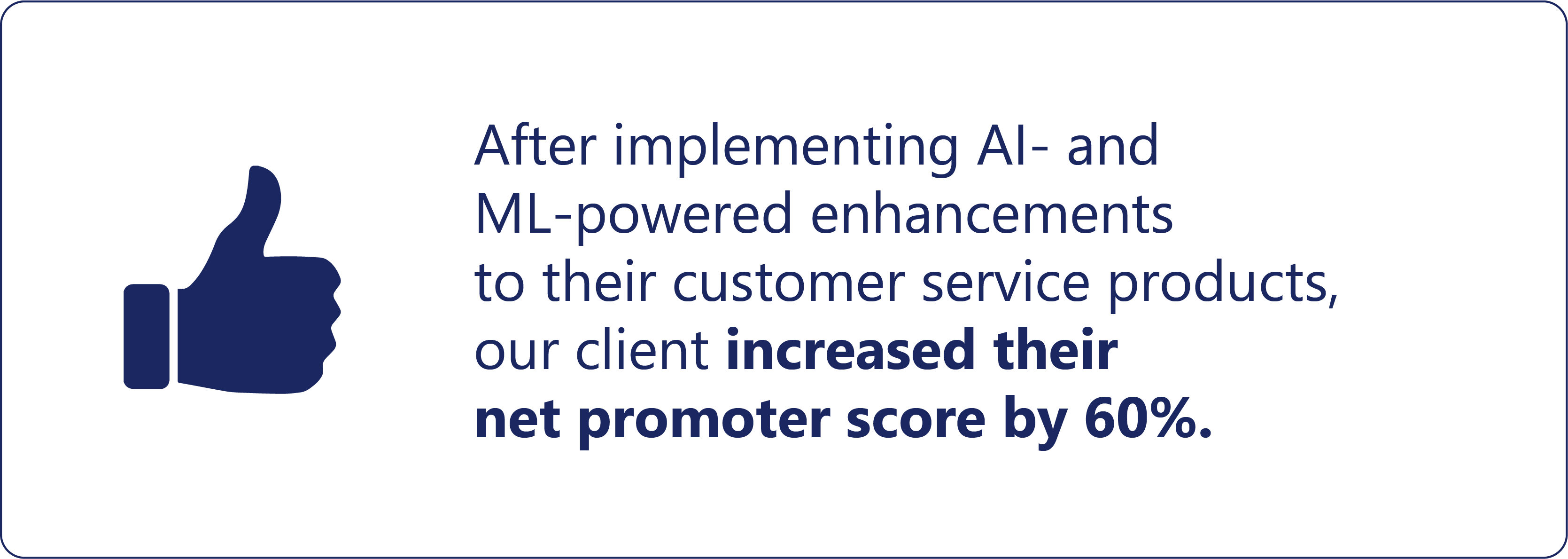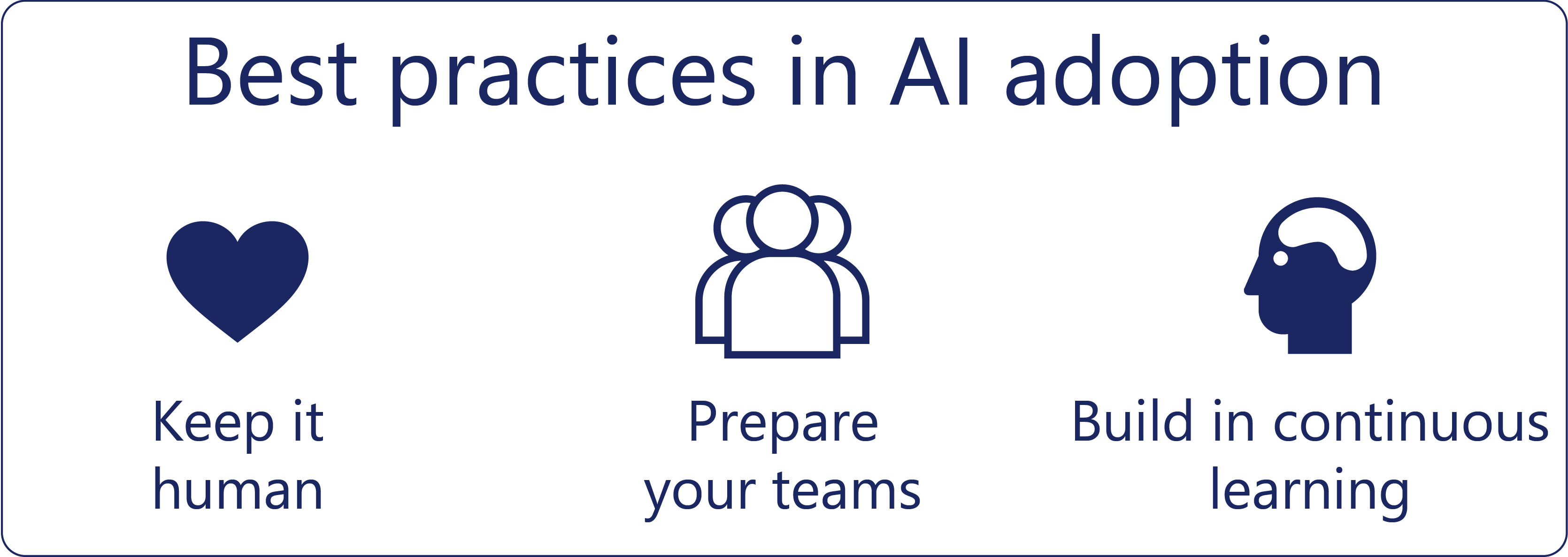7-minute read
Quick summary: Artificial intelligence and machine learning can help businesses enhance products and optimize processes without driving up operational costs, as one of our clients learned when we implemented call center AI.
When it comes to their products and processes, businesses have access to a solution that can help them improve and innovate without driving up operational costs: artificial intelligence (AI), including its subset machine learning (ML). According to recent studies, decision makers are increasingly eager to explore these opportunities: total AI investment in 2021 reached $77.5 billion, a 115 percent increase over 2020.
With the increased availability and declining costs of many AI-driven technologies, organizations of all sizes have a powerful asset in building products that address the myriad challenges of today’s business environment … if they take a strategic approach.

Case study: Using call center AI and ML to elevate a customer care product
Our telecom client has earned a stellar reputation for delivering outstanding customer service—as evidenced by a steady stream of awards and recognitions—yet they still wanted to take their customer experiences to the next level. Their experience with AI and ML had been limited, and they looked to us to put these technologies to work in helping them achieve their goals.
Our team got to work on a series of call center AI– and ML-powered enhancements of their existing customer service products, including
- A new feature on the messaging platform that gauges customer intent from the beginning of the interaction, allowing agents to be more targeted in the questions they ask
- Real-time analysis of chat transcripts and delivery of relevant resources directly to the agent’s dashboard, freeing agents from the need to hunt around for information
- Offering chat customers the option of working with an agent or using a do-it-yourself wizard to fulfill their request
- Integrating our solution into the client’s call center tools for agents
- Recognition and automatic masking of personally identifiable information (PII—for example, addresses and credit card numbers) in call and chat transcripts
- An automated memo function that analyzes transcripts and marks the topic of every line, creating a tagged document that makes it easy for agents to find information and freeing them from the need to take notes during a call
- Leveraged AWS to build scalable solutions
Our work has led to improvements in our client’s customer satisfaction (CSAT) scores, a decrease in call resolution times (CRTs), and a reduction in calls per account (CPAs). They also saw a 60 percent increase in net promoter score (NPS) and have been recognized by J.D. Power for several years in a row. Their highly valued customer care experts can focus on their conversations instead of searching for information and making notes, improving the experience for both agents and customers. The reduction in call resolution times has generated significant cost savings and opened opportunities to drive new business via cross-selling and upselling.

Benefits of adding AI and machine learning to products
Incorporating AI and machine learning at scale can be as beneficial to existing products and processes as it is to those designed with an “AI first” approach from the very beginning. In the above project and in many others, we’ve helped clients realize a wide range of benefits from AI and ML, including …
Growing productivity
AI-driven products enable organizations to do more without adding more people or overloading their existing personnel. For example, the solution we just described makes it easier to serve multiple messaging customers at a time by highlighting the topic of each conversation, providing the agent with an instant reminder of each interaction as they move between screens.
Putting data to work
Artificial intelligence applications can analyze massive amounts of data in a fraction of the time it would take a human, making data-driven insights available in real or near-real time. When our client’s customer care agents take a call, our solution understands the topic of the conversation and searches through thousands of articles to locate the information the agent needs in a matter of seconds.
Reducing or eliminating mundane tasks
AI functionalities can relieve human employees from repetitive, mundane tasks and allow them to focus on challenging, engaging work that adds value to the organization. Writing notes to document conversations was one of the least-liked tasks among our client’s customer care agents, but now that transcripts are being created, categorized, and tagged automatically, the team can focus on what they do best—building solid relationships with customers.
Giving structure to unstructured data
AI-powered apps can “read” through unstructured data—such as voice conversations—and turn it into searchable information that can be used in other applications. Because our solution connects each line of a transcript with a specific topic, agents can easily find the information they need without having to read through the document line by line.

Getting started
The task of building AI-driven products—or incorporating AI into existing progress—can appear daunting at first. Here are a few practices that can help you get started on the right foot:
Start with good data
AI and machine learning rely on high-quality data. Before you begin your implementation, make sure that the data that will feed into your application is accurate, current, reliable, consolidated, compliant, and ready to be used.
Determine what will go into your MVP
If you’re creating an AI-powered product from scratch, building a minimum viable product (MVP) offers the chance to test your concept with real users early in the development cycle. Avoid the temptation to include all your intended bells and whistles in the MVP; refer back to the best practice “begin with the end in mind” and include only the essential functionalities that users need to accomplish their tasks.
Avoid over- and underfitting
When putting together training data and building your model, be careful to avoid the two extremes of overfitting and underfitting. An overfitted model is one that aligns too closely with the training set, incorporating noise and random fluctuations alongside valid data. The result is a model that performs perfectly with the training set but can’t handle new data.
Underfitting occurs when the model is too loosely aligned with the training data. The result is a model that performs poorly both with the training set and with new data, and in practice it can actually be less reliable than random guesses. Aim for a goal of hitting the “sweet spot” between over- and underfitting to optimize your model’s performance.

A new era of AI-supported products
As artificial intelligence and machine learning technologies become more accessible, more and more organizations are incorporating these solutions into their products and processes—new and existing, internal and external. The next time you look at areas that could use a competitive boost, consider exploring the benefits that AI- and ML-driven platforms have to offer. And if you need help with that, just give us a call.

Claim your competitive advantage
We create powerful custom tools, optimize packaged software, and provide trusted guidance to enable your teams and deliver business value that lasts.

Pavel Lyubich is is an Architect in Logic20/20’s Digital Transformation practice.

